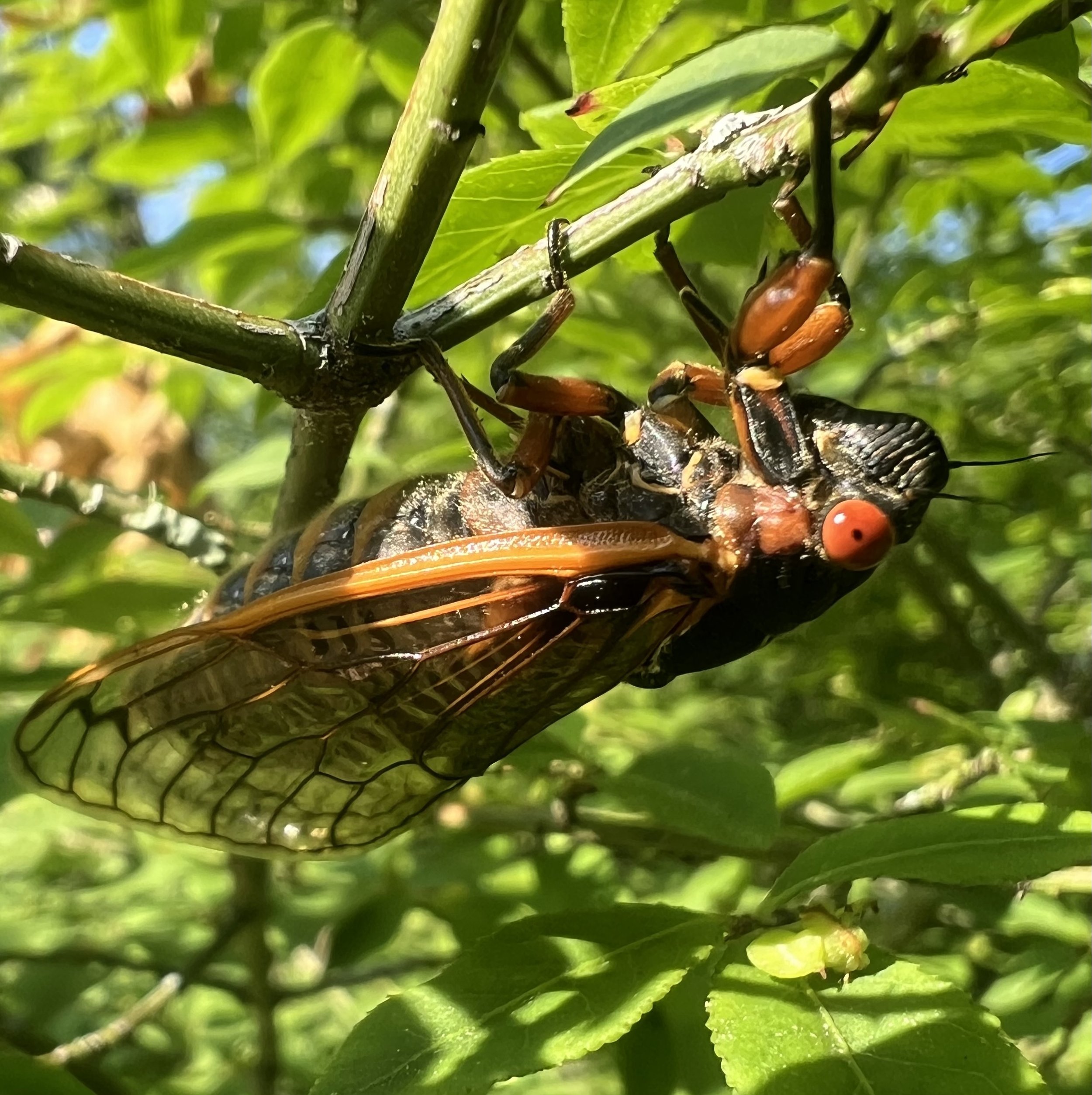Wings, Songs, and Soil: Cicada Brood XIV Returns to Cape Cod
An adult Cicada phase hanging out on the branch of a shrub.
Something remarkable is happening this spring in parts of Massachusetts. In wooded neighborhoods, quiet parks, and forested hillsides, the ground has stirred and the trees have started to sing. Brood XIV, one of several groups of 17-year periodical cicadas in the eastern United States, has emerged in striking numbers across parts of Cape Cod and southeastern Massachusetts.
For residents and visitors unfamiliar with these rare events, the experience may be startling. The sound is intense, the insects are numerous, and the biological story behind it is extraordinary.
What Is Brood XIV?
Brood XIV is a population of periodical cicadas—Magicicada septendecim, cassini, and septendecula—that lives underground for exactly 17 years. Synchronized by soil temperature and internal timing mechanisms, they emerge en masse for a brief, high-energy reproductive event. They are distinct from the annual cicadas found each summer. Periodical cicadas are smaller, with black bodies, red eyes, and transparent wings edged in orange.
Although Brood XIV has a wide range across parts of the eastern U.S., its reappearance on Cape Cod—particularly in towns like Bourne and Barnstable—is noteworthy. The region is not commonly associated with large cicada populations, making this localized emergence a rare opportunity for observation.
Why the Noise?
The loud, high-pitched sound filling the air is produced by male cicadas using specialized organs called tymbals. These structures vibrate rapidly, generating a rhythmic buzz that can reach 100 decibels—similar to a lawn mower or motorcycle. Each species has its own distinct song, which females use to choose a mate.
This acoustic display is not just loud—it is also tightly synchronized. The result is a sustained, daytime chorus that can dominate entire landscapes.
A Survival Strategy
The sheer number of cicadas is no accident. It is a survival strategy called predator satiation. Birds, raccoons, squirrels, and other predators cannot consume the entire population. By emerging all at once in overwhelming numbers, enough individuals survive to reproduce and carry the cycle forward.
After mating, females make small cuts in tree branches to deposit their eggs. The nymphs hatch, fall to the ground, burrow into the soil, and begin a new 17-year development period. The next time this brood will emerge is in 2042.
Why Some Areas Are Silent
One of the more surprising aspects of this event is how uneven it can be. A single neighborhood may be teeming with cicadas while the next appears unaffected. This variability reflects subtle differences in land use, vegetation, and soil.
Cicadas lay eggs in tree branches, so areas with mature, undisturbed hardwood trees are more likely to support healthy populations. In contrast, neighborhoods that were cleared, developed, or heavily disturbed 17 years ago may not see significant activity today.
Should People Be Concerned?
Periodical cicadas do not pose a threat to people, pets, or property. They do not bite or sting, and they do not damage gardens or agricultural crops. The only caution involves young or newly planted trees, as egg-laying can cause minor injury to small branches. Simple protective netting can help shield vulnerable trees until the event concludes in late June.
Ecological Significance
Despite their noisy arrival, cicadas provide a number of ecological benefits. Their mass emergence creates a short-term pulse of protein for a variety of predators. Their bodies enrich the soil with nutrients as they decompose. Their underground activity helps aerate the ground, and their egg-laying can naturally prune trees, stimulating new growth.
Perhaps most importantly, cicadas serve as a biological indicator of long-term environmental continuity. Their life cycle depends on habitat stability over decades, meaning their presence points to landscapes that have remained relatively undisturbed for generations.
A Brief and Rare Opportunity
Cicada emergences are one of the few large-scale natural spectacles that require no ticket or planning. They happen spontaneously and broadly, wherever conditions are right. On Cape Cod and in parts of southeastern Massachusetts, this is one of those rare moments.
Residents may find cicadas on porches, clinging to trees, or crunching underfoot on trails. Visitors may hear them while hiking or driving with the windows down. Whether experienced by chance or with intention, Brood XIV is a biological phenomenon worth noticing.
Until Next Time
By early July, the forest will fall quiet again. The cicadas will have completed their life cycle, and the next generation will be underground, beginning its long countdown to 2042.
In the meantime, take the opportunity to listen, observe, and appreciate a natural event that bridges decades—and reminds us how much is always happening just beneath the surface.
Used up Cicada shells, or exoskeletons, left clinging to the pine needles of a scrub pine.






